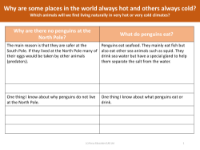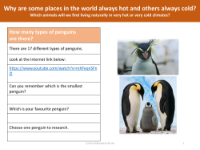Emperor penguins - Info sheet

Geography Resource Description
Emperor penguins are distinguished by their striking yellowy-gold markings on their heads and necks, setting them apart from other penguin species. Not only are they visually unique, but they also hold the title of being the largest of all penguin species. These remarkable birds spend their entire lives on the icy continent of Antarctica, where they have adapted to the harsh conditions. To combat the extreme cold, Emperor penguins have developed a social behaviour of huddling together for warmth, which is crucial for their survival in the frigid environment.
When it comes to reproduction, Emperor penguins lay their eggs typically in July, and it takes around two months for these eggs to hatch. In a remarkable display of parental care, the male Emperor penguin takes on the responsibility of protecting the egg by keeping it secure in his brood pouch, ensuring the offspring's safety in the treacherous Antarctic climate. These penguins are also adept swimmers and divers, capable of staying submerged underwater for over 20 minutes, which is essential for their hunting. However, despite their resilience and adaptations, the Emperor penguin is classified as an endangered species, with global warming posing a significant threat to their existence. To enhance understanding and retention, partners are encouraged to read the 10 facts about Emperor penguins and then quiz each other on the information, fostering interactive learning.








